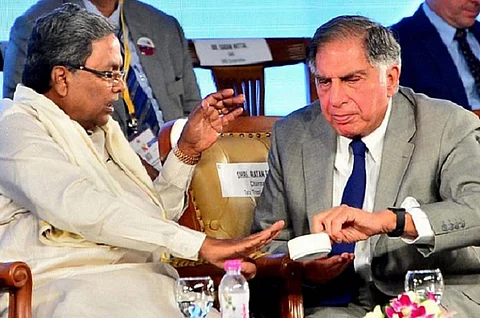

After four editions of Karnataka’s much-hyped investor meets, the story is a familiar one: the meet kicks off with much anticipation and sure enough it brings much hope and promise to the state with astronomical figures of industrial investment to be pumped into the state.
But a few months later, the bad news inevitably trickles in: many or most of the promised investments for which Memorandums of Understanding are signed have gone up in smoke.
2016’s Invest Karnataka global investors meet too made much of the fact that investments worth Rs 3 lakh crore have been attracted to Karnataka. And predictably, with little more than a month to go for the May 15 deadline for companies that signed MOUs to submit applications for clearances, The Times of India reported that only 18 applications have been filed, and quoted sources saying that less than 15 per of promised investments will see traction.
Industries Minister RV Deshpande objects to the TOI reading of the situation. He argues that it is impossible to expect industrial investments to fall into place completely in just two months. Observing that the government’s nodal officers are working closely with the various businesses that have signed MOUs at the investors’ meet, and that all projects are being comprehensively reviewed and cleared, he urged waiting till the May 15 deadline before passing judgement on the meet’s success or failure.
However, history isn’t on the minister’s side. According to a report in the Mint, only 9 per cent of the commitments made in the 2012 Global Investors’ Meet were realized on the ground. The 2010 Meet showed an implementation rate of just 28 per cent.
The question then arises, do mega investor meets of this kind provide any benefit to the state. Industry experts do not think so.
Former president of the Federation of Karnataka Chambers of Commerce and Industry, Jacob Crasta, for instance, feels that without sustained, on-ground changes to the infrastructure climate, global investor meets are just a periodic eyewash.
He feels that in terms of land policy, provisioning for water and electricity or development of roads, Karnataka lags badly, and the failure of the state to provide such fundamental infrastructure drives investors away from the state.
“First, the government needs to give industries the freedom to buy land.” And this land has to be provided at competitive rates, he adds. “Secondly, the government have to bring water to industrial estates.” The third requirement is for adequate road and air connectivity across the state. “Right now they have dumped everyone in Bangalore,” he says. And finally, proper power supply is a necessary prerequisite.
Beyond these infrastructural developments, says Crasta, the official attitude towards industry has to improve if any significant change has to take place. “The government has to have an outright forward looking attitude.” A fundamental priority towards industry and industrialization is key.
Problems of infrastructure as well as delays and tangles in land acquisition and official clearances, have consistently been pointed out as problems faced by investors in the state. The Mint article, for instance, cited these reasons for companies like Hero MotorCorp setting up its factory in Andhra Pradesh, and e-retailer Amazon setting up its warehouse in Telangana.
Without concrete changes on these fronts, observers say, expressions of interest will not convert to investments on the ground. And from the perspective of brand strategy, big investors’ meets could do more harm than good for Karnataka’s attempts to project itself as an investment destination, they say. Brand expert Harish Bijoor, for instance, says that the primary problem is one of image and integrity.
Seeing repeated cycles of jamboree-like investor meets where the money rarely hits the ground, says Bijoor, actually reduces the integrity quotient of the government. “What matters is the money that hits the ground. And performance has to be pegged on certain other targets like job creation, and how much money has actually come in, how many livelihoods created.”
Even if the numbers are small, he says, it is a better brand strategy to be transparent about them and the reasons behind them, and focus on inching the numbers upwards.
But the bigger is better mindset seems to have stuck, and not only in Karnataka’s case. The News Minute had earlier reported how the bombastic numbers announced at the Tamil Nadu Global Investors Meet in 2015 hid a track record of poor on-ground implementations of promised investments.
Indeed, data from the Directorate of Industrial Policy and Promotion for the period from 2011 to 2015 showed an average implementation rate of 5.64 per cent. The same figures also offers similar numbers for Karnataka.
In 2011, for instance, out of Rs 95,153 crore worth of Industrial Entrepreneurial Memoranda (IEMs another name for MOUs) signed, only Rs 890 crore were implemented. In 2012, the numbers stood at Rs 47,967 crore worth projects signed, and only Rs 1,672 crore worth projects implemented. In 2013, the amount for IEMs signed was Rs 10,050 crores, while implementation stood at Rs 4,912 crores. And in 2014, agreements were signed for Rs 21,866 crores but only Rs 2,361 crore worth projects were implemented.